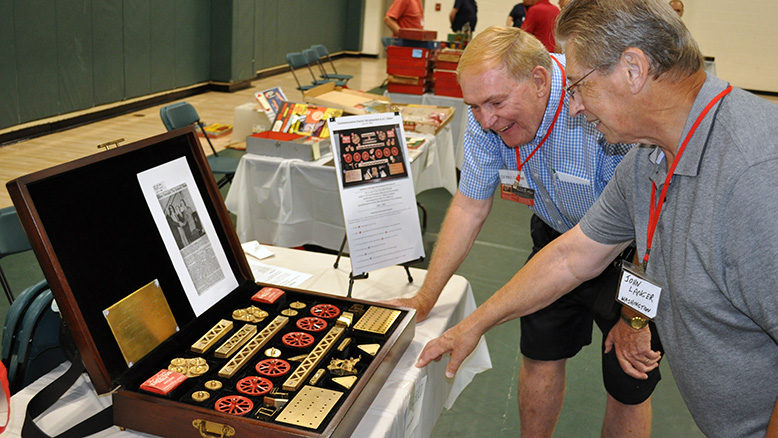- Upcoming Events
Please join us for the 2025 ACGHS Spring Midwest Regional Meet on Saturday, March 29, 2025 from 8:00a to 12:00 Noon at the Faith Community Center, 5572 Mercy Way, Lafayette, IN 47905 . We can start setting up at 8:00a. Like in years past, we will have to set up and take down the tables we use and clean up after the show. The show is from 8:30a to 11:30a. We will have a brief Regional Meeting of ACGHS Members after the show. The show is Free. Learn more on our Calendar of Events page.
The 2025 A. C. Gilbert Heritage Society National Convention will be held July 10-12, 2025, in historic York, Pennsylvania. Our hosts will be Gary and Lisa Treible. The convention show and banquet will be held at the Wyndham Garden York, 2000 Loucks Road, York, PA 17408. Check our Calendar of Events page for all the latest updates: Calendar of Events page.
Continue reading → - Need a New Home for Old Erector Sets?
by Tim Wilkin
Are you looking for a new home for one or more old Erector Sets you no longer want? Here are some suggestions for donation of your Erector sets.
If the set contains parts that are in good shape and sufficient to make at least some of the basic models, I’ve found that local foster homes will often accept items like this for the kids to build and play with. I’ve given 13 sets to foster homes with good results. Also, if you have suitcases you no longer use, foster homes are frequently forced to send kids to a home with their belongings in a trash bag for lack of a better option, so you may also be able to help boost a kid’s self-esteem by providing a suitcase.
Another possible place to donate a set is to grandparents of an 8-12 year old boy. Grandpa may have had one as a kid and it gives the grandparent and grandchild a bonding opportunity. I’ve given 12 sets away to grandparents and grandkids in the past couple of years.
Finally, the A.C. Gilbert Heritage Society has national and regional conventions where models are showcased and the general public gets to enjoy a bit of toy history for a few hours. At several of the national conventions, members have donated sets or portions of sets for kids to build and take home a simple model. This past summer, the emphasis was on STEM training in schools, and parts to build an improved model of a walking giant were donated and the students challenged to engineer improvements to the original design. This worked well. If you decide on this option, I can reach out to this year’s sponsor for the national convention and get the two of you in touch. If you decide on this option, use our Contact Us form and I can connect you with this year’s sponsor for the ACGHS National Convention.
Continue reading → - Guide to Gilbert Erector Sets, 1913-1932
Fourth Edition
On October 2, 2023, the A. C. Gilbert Heritage Society released the fourth edition of Bill Bean’s Guide to Gilbert Erector Sets, 1913-1932. Recent revisions include:
- A few typos and errors have been corrected in the text.
- Recently uncovered factory-printed contents lists have been incorporated into the Appendix: 1914 Nos. 4 and 8; 1915 No. 2; 1916-1918 Nos. 1 and 5; 1919 No. 2; 1921 No. 4; 1922 Nos. 4 and 8; 1923 Nos. 1 and 7; two versions of 1924-1925 No. 4; and two versions of 1928 No. 77. Sets that were dropped by Gilbert have been removed from the contents lists: 1920 No. 4; 1922 No. 6; and 1923 No. 6. Finally, different sizes of the (GY) metal Erector trays packed in 1929-1930 Nos. 7, 7½, 8, 9, and 10; and in 1931-1932 Nos. 7, 7½, 8, 8½, 9, and 10, have been noted.
Retrieve a listing of the revisions and corrections to the Fourth Edition of the guide: October 2, 2023 corrections and updates (PDF | 6 pages)
Members of the A. C. Gilbert Heritage Society can retrieve a PDF of the entire revised Appendix, pages 191-222, by logging in and selecting Erector Contents Lists from under the Erector Sets heading in the top navigation bar.
Here are the particulars for Bill Bean’s Guide to Gilbert Erector Sets, 1913-1932:
- Fourth Edition, October 2, 2023
- Price: $49
- Publisher: A. C. Gilbert Heritage Society
- Language: English
- Paperback: 224 pages
- ISBN-13: 978-0-578-99437-6
- Item Weight: 1.45 pounds
- Dimensions: 8.5 x 0.53 x 11 inches
Order your copy of Bill Bean’s Guide to Gilbert Erector Sets, 1913-1932 from Amazon today.
Continue reading → - Guide to Gilbert Erector Sets, 1933-1962
Third Edition
The Third Edition to Bill Bean’s Guide to Gilbert Erector Sets, 1933-1962 was released on April 23, 2023. Minor revisions to the text include:
- Page 50: No. 6½ – The Super No. 6½ sold for $7.95 (not $6.95); No. 7½ – The Engineer’s Set sold for $10.95 (not $15.95).
- Page 254: quantity of (NZ) Plastic Handle Screw Driver for 1959 Set No. 10053 corrected from 0 to 1.
This guide is a comprehensive update to the 1998 edition of Greenberg’s Guide to Gilbert Erector Sets, Volume Two, 1933-1962. The revised and updated guide features dozens of new photographs of Erector sets and component parts, and includes Contents Lists for every set from 1933-1962. This is the companion guide to Bill Bean’s Guide to Gilbert Erector Sets, 1913-1932, published on November 15, 2021 (learn more here).
Here are the particulars of the new guide:
- Third Edition, April 23, 2023
- Price: $59
- Publisher: A. C. Gilbert Heritage Society
- Language: English
- Paperback: 262 pages
- ISBN-13: 979-8218077501
- Item Weight: 1.68 pounds
- Dimensions: 8.5 x 0.62 x 11 inches
Order your copy of Bill Bean’s Guide to Gilbert Erector Sets, 1933-1962 from Amazon today.
Continue reading →

